Hello there! Thanks for joining me on my next outdoor adventure as I explore the best walks of the capital. Today’s stroll begins in Highgate’s Waterlow Park, takes me past the Highgate Cemetery and onto the woodland wonders of Highgate Wood. I’ll take a detour up to the renowned Alexandra Palace and finish the walk at Finsbury Park. So let’s get going!

I do love it when my walks start with a picturesque entrance and Waterlow Park in Highgate provides just this, with a very welcoming park gate which says to me ‘Come on in’.

The park’s history dates back to the 16th century where the area was known for its affluent residents, many of whom built homes and fine gardens, some of which are now within Waterlow Park. One of the attractions to the residents was that the air was cleaner than other parts of London.
A walk through the park illustrates just how peaceful it is and that with every turn there’s something of glorious green to see!




You’ll never struggle to find a spot to sit, or to grab a photo of the park.

Another one of the attractions of people moving to Highgate in the 16th Century was the plentiful water supply from the park’s three historic ponds which are still fed by natural springs. I always think a park isn’t complete without a pond or a lake, there’s something very satisfying about hearing the trickling of water in a tranquil park setting.


At the head of the park and sitting grandly on the top of the hill is Lauderdale House which was the home of the Earl of Lauderdale in the 17th Century. The house today is a delightful cafe where you can stop for a spot of tea or light lunch, with a view overlooking the glorious grounds of the park. The garden area of the house is commonly noted as one of the very early examples of terraced gardens in Britain. It really doesn’t feel like a park, more that you’ve wandered into someone’s estate and garden!


During the 17th Century there was a home within the park for the poet Andrew Marvell where a bronze plaque within the park dedicated to him stands. Another resident in the park was prolific architect and park designer Sir James Pennethorne who unsurprisingly helped with designing some of the elements of the park.

From 1856 English philanthropist and Liberal Party politician Sydney Waterlow lived within the park and soon acquired the neighboring properties to create his own mini-estate, with Lauderdale House being let out as Convalescent homes for medical professionals.
However, Sydney Waterlow didn’t stay long at the estate and it remained empty and deteriorated for a number years until he presented it to the London County Council in 1889 and it was termed as ‘a garden for the gardenless’. So if you didn’t have a garden, you could enjoy it as your very own one. The council named it after Sydney and ensured that all the historic features within it remained.
It’s time to leave Waterlow Park and as you head out you take a stroll past Highgate Cemetery. Established in 1839, the cemetery is split into the West and East Cemeteries with approximately 170,000 people buried in and around the 53,000 graves.

Spanning 15 hectares (37 acres) in size, the cemetery was acquired by The Friends of Highgate Cemetery Trust in 1975 with them acquiring the freehold to both the East and West Cemeteries by 1981.
Some of the notable people within the East Cemetery include the tomb of Karl Marx, the ashes of the author of The Hitchhiker’s Guide to the Galaxy, Douglas Adams, William Foyle (co-founder of book store Foyles), Sir Thomas Lauder Brunton, 1st Baronet (Scottish physician known for his work in the treatment of angina pectoris), Patrick Caulfield (painter and printmaker known for his pop art canvasses) and Roger Lloyd-Pack (British actor).
Within the West Cemetery notable people buried there include Julius Beer (Owner of the UK newspaper The Observer), James Bunstone Bunning (City Architect to the City of London), Charles Cruft (founder of Crufts dog show), the parents, wife and brother of Charles Dickens, Lucian Freud (painter, grandson of Sigmund Freud, and elder brother of Clement Freud), Bob Hoskins (actor), George Michael (singer), and Jean Simmons (actress).
Additionally, there are the graves of 318 Commonwealth service personnel with 259 from the First World War and 59 from the Second.
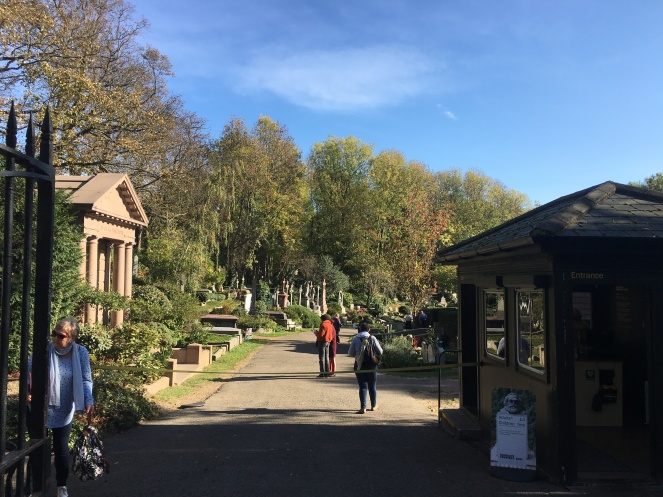
It’s now time to move on to my next stop on today’s walk, Highgate Wood! To do so I get to walk through Highgate and experience what a pleasant area it is, with it having a real village feel about it. With cute little houses, village greens and not a great deal of traffic, you forget you’re still in London!



Now this is one true hidden gem of London that I’m about to explore! Lying between East Finchley, Highgate Village and Muswell Hill, Highgate Wood is a 28 hectare (70 acre) ancient woodland.
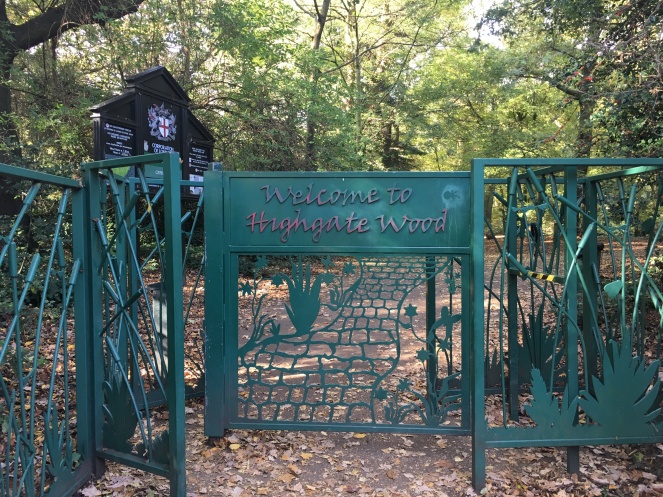
Highgate Wood appears within the Ordnance Survey map of Middlesex in 1886 which illustrates the area’s illustrious history. Predominately an oak, hornbeam and holly wood, there are more than 50 tree and shrub species within the woodlands. The wood is also home to the rare deciduous tree with brown berries, known as The Wild Service Tree or the Sorbus torminalis.

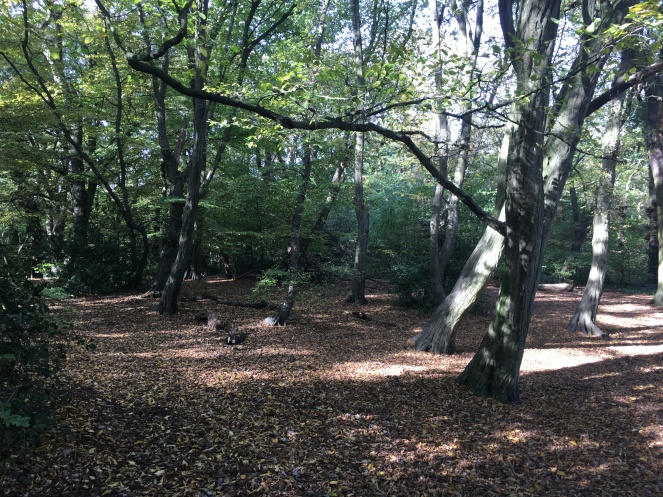

The woods aren’t just home to trees and plants, but 71 different species of bird have been recorded there, as well as foxes, grey squirrels, seven species of bats, 180 species of moth, 12 species of butterfly and 80 species of spider!
There have also been prehistoric flints found within the wood with excavations from Romano-Britons found which indicated that pottery materials were produced from local materials between AD 50-100.


The wood hasn’t always been well maintained or looked after with The City of London Corporation’s not being sympathetic to the historical origins. After they acquired it asphalt paths were laid, ornamental trees planted and dead wood removed and burned, with it being managed as more of an urban park than an ancient woodland.
In 1968 the Conversation Committee of the London Natural History Society became concerned after the planting of exotic conifers which were seen as inappropriate for an ancient woodland. Consequently, this type of planting programme was halted and hasn’t been used since.
Since then the management of the woodland has been more considered with little human interference. It’s listed as one of only eight Green Heritage Sites in London and is a Site of Metropolitan Importance for Nature Conversation. The woodland is currently a registered charity managed and funded by the City of London.

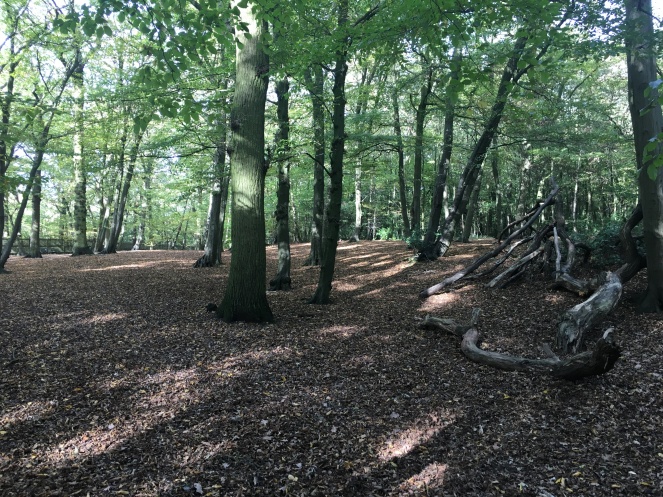
Walking through the woodland it does remind me of the Children’s rhyme a ‘Teddy Bear’s Picnic’ as it has that fairytale and adventurous feel you’d find in a storybook. With loads of campfires and logs for sitting on across the park, it really is a wonderful place for children to explore and to be introduced to the wonders of nature. It’s very easy to get lost within all the amazing trees and when you look up & across all you see is leaves and branches, something you don’t get to enjoy that much everyday. For as far as you can see, there’s nothing but the glorious woods and every time you take a stroll around it there’s something new and enlightening.
Having already discovered the breathtaking Russia Dock Woodland, Highgate Wood is certainly up there with it!
The wood isn’t just trees and plants, but a walk to the end of it takes you to a large open green field used for football and cricket.

As much as I’d love to spend all day in the woodland, I’m now going to head off to a place which gives you a truly wonderful view of London, Alexandra Palace.
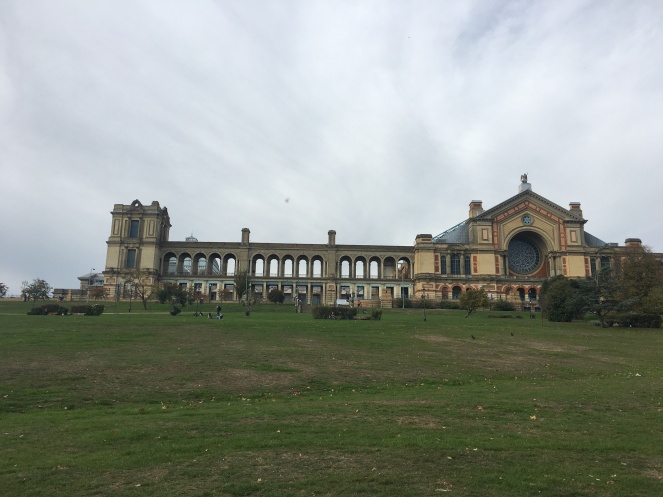
Known as ‘Ally Pally’, the palace was designed by Owen Jones, John Johnson and Alfred Meeson, and first opened in 1873 on Queen Victoria’s 54th birthday. The spectacular celebration for the opening included concerts, recitals and fireworks. However, just 16 days later a fire broke out in the Palace destroying the structure.
It wasn’t until two years later in 1875 that the new Alexandra Palace was opened to the public with it containing the new Henry Wills organ, one of the largest in Europe at the time. The palace also has the honour of having marksmen from the Alexandra Palace Rifle Society representing Great Britain in the 1908 Olympics where they won Gold, Silver and Bronze medals.
During the First World War the palace was used as a Belgian refugee camp and later as a German and Austrian internment camp.
One of the most significant events occurred on the 2nd November 1936 when the world’s first regular high-definition public television broadcast took place from the BBC studios at Alexandra Palace. A blue plaque is present to commemorate this and the TV mast is still there today. 1936 also saw the park become free for the public to use as a result of the 1900 Alexandra Park and Palace Act.



During the Second World War the palace was once again used by Belgian refugees with the transmitter tower being used as a decoy for enemy aircrafts.
The palace’s grounds were the home to horse racing until the racecourse was closed in 1970. In 1980, for the second time, a fire broke out across the palace burning a large part of the building. Substantial restoration began after the fire and it was reopened in 1988.

The palace was recognised in 1996 as a building of special architecture and historic significance with it receiving a Grade II listing. The venue has hosted a wide range of events including numerous concerts, Master Snooker, the World Darts Championship, Antiques Fairs, beer festivals, award ceremonies and a firework display every Bonfire Night.
One of the most prominent aspects of the palace and one that I thoroughly enjoyed is the stunning view you get of the capital from it. It’s such an awe-inspiring view across London of some of its most well-known landmarks, and great to experience them from another angle on my walks, having seen them on Hampstead Heath as well as Stave Hill! It always amazes me just how much you can from just one area of the capital and perfectly demonstrates that all of London’s landmarks are in such close proximity to one another!


Behind the palace is a pretty little lake and cafe, so it you require a bit of down-time and relaxation, it’s ideal for just that!
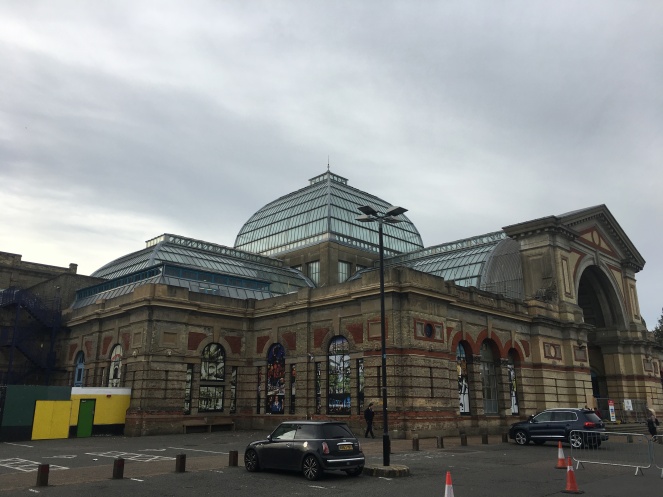
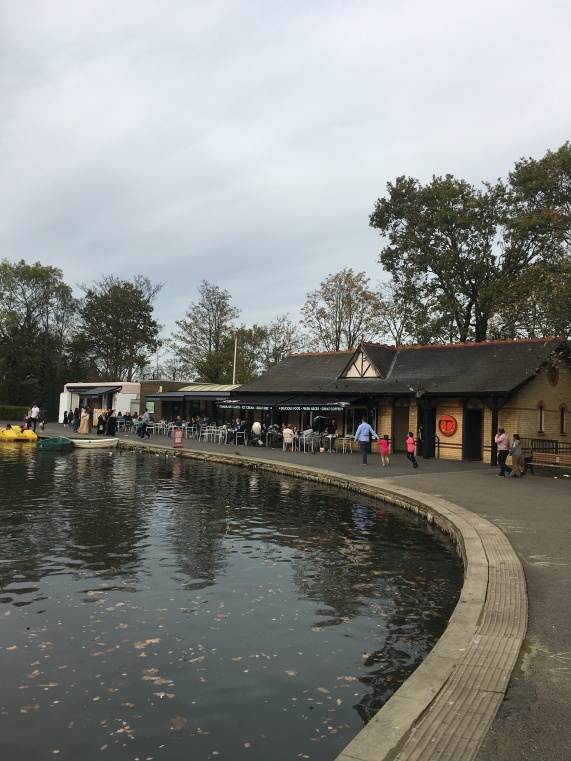

I’m now going to begin a stroll to my final destination on this walk, Finsbury Park by heading down the hills on Alexandra Palace!
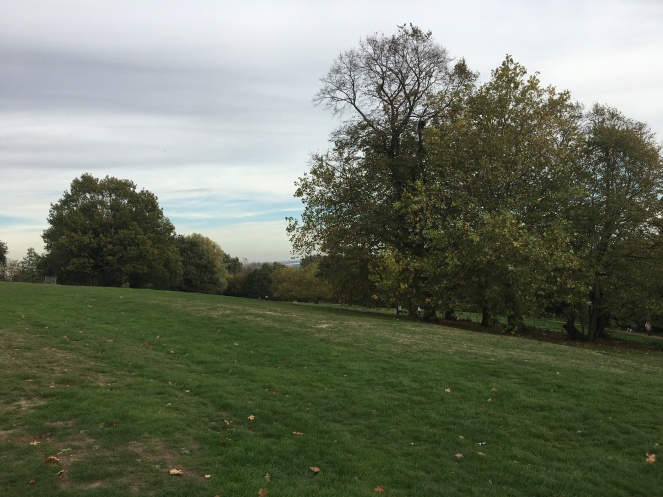
Once I’ve left there I walk down Priory Road through the quaint Priory Park.

The walk takes you along the road past the houses and Finsbury Park station until you get to the gates of the park.

Opened in 1869, the 46 hectares (110 acres) park was designed by Frederick Manable. Based in Harringay, it was one of the first of the great London parks laid out in the Victorian Era. The park was originally landscaped as a woodland area in the Manor of Brownswood and part of the woodland called Hornsey Wood which was cut back to be used as a grazing land in the Middle Ages.

In the 18th Century a tea room was opened where Londoners could enjoy the woodlands. These tea rooms were developed into larger buildings known as the Hornsey Wood House (Tavern). The area was also home to boating, shooting and archery, before the tavern was demolished in order to make the area into a park. Once the park opened, the pub across the park along the Seven Sisters Road called itself the Hornsey Wood Tavern after its original one! However, the tavern would close in 2007 with the area being developed.

In the 19th century Londoners began to demand more open green space, something which had become even more common in Paris. To counteract the increasingly urbanisation of London, in 1841 the people of Finsbury petitioned for a park to be developed to help eradicate the poor conditions in the city. The first plans for the park were drawn up in 1850 with its name originally being called Albert Park. However, it was renamed Finsbury Park and opened in 1869.

The park played a role in both the First and Second World Wars with it being the location for pacifist meetings in WWI, and used as military training grounds and hosting anti-aircraft guns in WWII.
Through the 1980s the park went into a decline and when its owner, the Greater London Council was wound up, Haringey Council took over the ownership of it. Luckily in 2003 the park was awarded £5 million from the Heritage Lottery Fund which helped with significant renovations to improve its facilities to enable the park we see today. The park is commonly known as the ‘People’s Park’ due to its strong community feel.
Well that’s all for this week’s walk of the capital which has seen us take a trip through Highgate’s park and woodlands, the spectacular architecture and views of Alexandra Palace, and the fabulous Finsbury Park.
Thanks for coming along on my walk and in the meantime you can catch me on Twitter and Instagram and don’t forget to sign up to my blog too and have a read of my other walks! 🙂
Sources: (not the food sauces)
All photos taken by London Wlogger. © Copyright 2018
Waterlow Park: History of Waterlow Park
Highgate Cemetery: History of Highgate Cemetery
Highgate Wood: History of Highgate Wood

A part of London I knew little about despite being a long-time resident there (no longer living in the capital and still miss it), so I am doub ly grateful for this walk which I enjoyed tremendously. You have really brought the park to life so thank you very much.
LikeLiked by 3 people
Aww thank you so much, glad I could bring you closer to its wonders! I agree these are areas you don’t normally visit or hear about so being able to showcase these is an honour 😊
LikeLike
Wish I’d had this a couple of months ago when we visited Ally Pally and Highgate cemetery. Excellent article.!
LikeLiked by 1 person
Ahhh hopefully if you visit again soon you can follow the walk with the blog 😃 Glad you enjoyed it 😊
LikeLike
Impressive parks. How long was the walk?
LikeLike
They’re very picturesque! I’d say you need to give yourself around three hours 😊
LikeLike
What lovely walk and interesting history! One doesn’t expect such calm in the heart of a city! 👍
LikeLiked by 1 person
Thanks so much! You’ll be amazed with what you can find when you explore London outside the tourist spots – parks, woods, rivers and cute little places 😃
LikeLiked by 1 person
Thank you for taking me back home. When I do travel there in real life, the time is taken up visiting family and friends. Next time I shall go on some of these walks instead.
LikeLiked by 1 person
Perfect I’m sure you’ll have such fun exploring these marvellous sights, they really are wonders of natural beauty!
LikeLike
I used to go running in Richmond Park to see the deer back in 1983 while I was a student. London has some truly beautiful parks.
LikeLiked by 2 people
Oh amazing what an ideal setting for a run! Its parks are one of London’s many unique and distinguishing features! 😊
LikeLiked by 1 person
I agree. 👍
LikeLiked by 1 person
I enjoyed this delightful walk. Thanks for the lovely photos and information about the places you passed.
LikeLiked by 2 people
Aww thank you, so glad you enjoyed it 😊
LikeLiked by 1 person
I enjoy your tours.
LikeLiked by 1 person
Thanks Sherry, hope you can do the walks some time!
LikeLike
Makes me want to return to your fair city. Thanks.
LikeLiked by 2 people
London would welcome you back 😉 And you can do all my walks when you visit!
LikeLike
have to bookmark this walk for my next London trip:)
LikeLiked by 1 person
Awesome you’ll absolutely love it Tanja, has everything you want from a walk! 😃
LikeLiked by 1 person
We love coming across wooded areas in the middle of the city.
LikeLiked by 2 people
It’s so unexpected isn’t it?! That’s why London always surprises you 😃
LikeLiked by 1 person
London is a surprisingly green city!
LikeLiked by 1 person
It is! Loads of rivers and canals too 😃 All perfect for walks!
LikeLiked by 1 person
Absolutely!
LikeLiked by 1 person
Wonderful walking with you!
It takes me back to my old stamping ground; my first flat in London was in Stamford Hill, nearest Tube Finsbury Park! Wonderful to see the photographs – those gates are just as I remember them!
I have always wanted to go into Highgate Cemetry. Is it open to the public? I don’t think it used to be.
Thank you for sharing!
LikeLiked by 1 person
Aww thank you so much, thanks for joining me! Glad I could bring back some happy memories 😊 Yeah it’s open to the public though you have to pay to enter!
LikeLiked by 1 person
Brilliant! I am sure that in the days when I lived there, it was off limits, which is a shame as it is so interesting. I shall have to visit next time I am back!
I lived for a while near Woking; the train station there was built to serve Brookwood Cemetery, which in turn was built to accommodate the overflow of corpses from London! Brookwood is really interesting too, but again, I don’t think that it is open to the public. (I am not obsessed with cemeteries, but they can be interesting places!)
Looking forward to joining you on your perambulations!
LikeLiked by 1 person
Ah yes I remember watching a programme about that! It was known as the Stiffs Express with many of those corpses starting at Waterloo station!
LikeLiked by 1 person
Wonderful! I did not know that!
LikeLiked by 1 person
Looks like a lovely walk – and not too far from me either! Maybe I should go for a winter picnic at Finsbury park at some point!
LikeLiked by 1 person
You definitely should haha, grab a flask of tea and some sandwiches, sit back and relax in a beautiful setting 😃
LikeLike